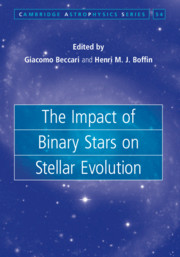Book contents
- Frontmatter
- Contents
- List of Contributors
- Foreword
- Introduction
- 1 The Zoo of Binary Stars
- 2 Statistics of Binary and Multiple Stars
- 3 Gaia and LSST: Their Importance in Binary Star Research
- 4 Population Synthesis of Binary Stars
- 5 Low- and Intermediate-Mass Star Evolution: Open Problems
- 6 The Symbiotic Stars
- 7 Binary Post-AGB Stars as Tracers of Stellar Evolution
- 8 The Importance of Binarity in the Formation and Evolution of Planetary Nebulae
- 9 Massive Star Evolution: Binaries as Two Single Stars
- 10 Binarity at High Masses
- 11 Luminous Blue Variables: Their Formation and Instability in the Context of Binary Interactions
- 12 Type Ia Supernovae: Where Are They Coming From and Where Will They Lead Us?
- 13 Binary Interactions and Gamma-Ray Bursts
- 14 Binaries as Sources of Gravitational Waves
- 15 The Impact of Binaries on the Stellar Initial Mass Function
- 16 The Formation of Binary Stars: Insights from Theory and Observation
- 17 The Maxwell’s Demon of Star Clusters
- 18 Alternative Stellar Evolution Pathways
- 19 Clocks and Scales: Playing with the Physics of Blue Stragglers
- 20 Binaries at Very Low Metallicity
- 21 Population and Spectral Synthesis: It Doesn’t Work without Binaries
- Index
6 - The Symbiotic Stars
Published online by Cambridge University Press: 05 April 2019
- Frontmatter
- Contents
- List of Contributors
- Foreword
- Introduction
- 1 The Zoo of Binary Stars
- 2 Statistics of Binary and Multiple Stars
- 3 Gaia and LSST: Their Importance in Binary Star Research
- 4 Population Synthesis of Binary Stars
- 5 Low- and Intermediate-Mass Star Evolution: Open Problems
- 6 The Symbiotic Stars
- 7 Binary Post-AGB Stars as Tracers of Stellar Evolution
- 8 The Importance of Binarity in the Formation and Evolution of Planetary Nebulae
- 9 Massive Star Evolution: Binaries as Two Single Stars
- 10 Binarity at High Masses
- 11 Luminous Blue Variables: Their Formation and Instability in the Context of Binary Interactions
- 12 Type Ia Supernovae: Where Are They Coming From and Where Will They Lead Us?
- 13 Binary Interactions and Gamma-Ray Bursts
- 14 Binaries as Sources of Gravitational Waves
- 15 The Impact of Binaries on the Stellar Initial Mass Function
- 16 The Formation of Binary Stars: Insights from Theory and Observation
- 17 The Maxwell’s Demon of Star Clusters
- 18 Alternative Stellar Evolution Pathways
- 19 Clocks and Scales: Playing with the Physics of Blue Stragglers
- 20 Binaries at Very Low Metallicity
- 21 Population and Spectral Synthesis: It Doesn’t Work without Binaries
- Index
Summary
Any white dwarf or neutron star that accretes enough material from a red giant companion, such that this interaction can be detected at some wavelength, is currently termed asymbiotic star (orbital period ∼2–3 years). In the majority of ∼400 known systems, the white dwarf burns nuclearly at its surface the accreted material, and the resulting high temperatureand luminosity allow ionisation of a large fraction of the cool giant’s wind. X-ray observations are revealing the existence of a parallel (and large ?) population of optically quiet, accreting-only symbiotic stars. Accretion flows and disks, ionisation fronts and shock, complex 3D geometries and new evolution channels are gaining relevance and are reshaping our understanding of symbiotic stars. The chapter reviews the different types of symbiotic stars currently in the family and their variegated outburst behaviours.
- Type
- Chapter
- Information
- The Impact of Binary Stars on Stellar Evolution , pp. 77 - 91Publisher: Cambridge University PressPrint publication year: 2019
- 1
- Cited by

